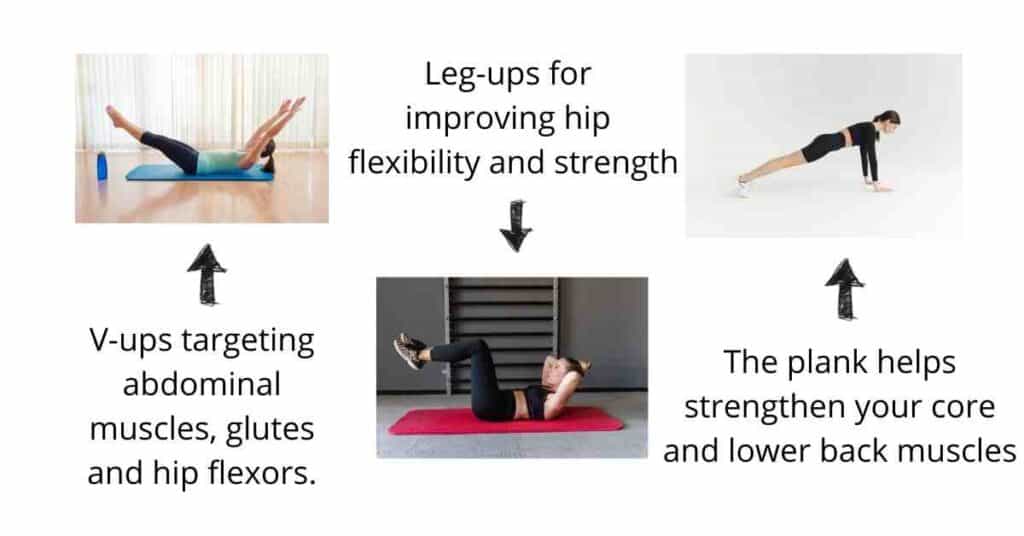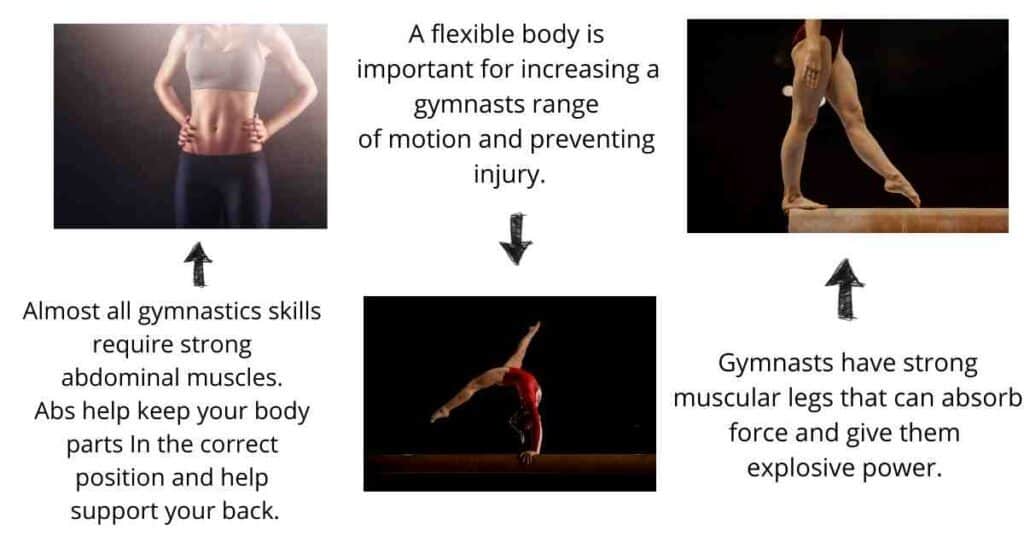Gymnastics is a sport featuring exercises that display coordination and physical agility. This exciting sport lets the audience appreciate the lovely and flowing motions, physical strength and agility on display in a number of unique skills. Although gymnastics is open to male and female athletes, many women still wonder about the strength required to participate in gymnastics and want to know why female gymnasts are so muscular.

Gymnasts are among the strongest athletes in sport due to the nature of the gymnastic exercises they practice and learn. “Being a gymnast is having the strength to hold on and the courage to let go.” This phrase is one of the famous sayings in gymnastics, touching on the importance of strength.
This article explains gymnasts’ training routines and the average body type of female and male gymnasts. It also covers the benefits of gymnastics and its advantages over other sports. This information can help you better understand why gymnasts are strong, what it takes to be a gymnast and how you can benefit with increased strength and lifestyle improvements.
How Do Gymnasts Train?
Gymnasts combine quality exercises and nutritional plans to get their poise and well-rounded athletic skills. The training programs typically incorporate core conditioning such as V-ups, leg lifts, crunches, planks, and handstand presswork. Besides, gymnasts spend plenty of time on flexibility. Most programs require you to perform an active mobility routine at the beginning of your practice. They also include longer stretches that you hold for 30 seconds or more toward your practice’s conclusion.

You can also find cardio work in the training practices to facilitate tolerance during longer sessions. It also boosts stamina during floor routines and aids in fat loss to enhance flexibility. Most cardio work features interval work, where you have a sprint before an easier recovery phase. However, you can get some steady and slower cardio programs, such as a 30-minute jog. Gymnastics training focuses more on how well you perform the exercise rather than just going through the motions. A healthy eating pattern is an essential component of proper gymnastics training, letting you maintain low body fat levels.
The diet includes healthy fats, seeds and nuts for vitamins and minerals, and lean protein for muscle recovery and repair. It also involves fluids for hydration and carbohydrate properly timed for optimal energy generation.
What Body Type Do Female Gymnasts Have?
Women gymnastics typically has two body types. One kind is the short and muscular females like 2008 gold medalist Shawn Johnson. In contrast, the other type is the thin and willowy bodies, such as the 2008 Olympic gold medalist Nastia Liukin. Generally, female gymnasts feature a lighter bodyweight than males, who have larger and evident shoulder muscles. Despite this, female performers have broad shoulders and firm muscle development, making them very strong. Regardless of gymnastic skills, strength is imperative to balancing, controlling, and moving your body and other accessories.

Female gymnasts also have a small frame, unlike the men, who have closer to average size. Hence, many gymnasts often have short gymnast legs and arms. The light and more petite frame aids a gymnast in achieving a high strength-to-weight ratio. It also helps a performer develop rotational skills, such as somersaults.Lastly, female and male gymnasts have flexible bodies. Even though flexibility is not necessarily a prerequisite, it is critical to executing specific movements. Gymnasts begin the sport at a young age, typically nine years or below. The stretching regime during training makes them flexible. However, if you join it later, you need your body to attain a certain flexibility level to execute the exercises.
What Benefits Do Gymnasts Have Apart from Physical Fitness?
Physical fitness, strength and flexibility are the most apparent benefits of being a gymnast. Nonetheless, the sport offers several advantages to performers that go beyond looking and feeling fit. Below are the three primary benefits you can enjoy as a gymnast:
a) Healthy Lifestyle
Gymnastics training programs mean you have a busy daily schedule, reducing the chances of risky behavior from idleness. You also take better care of your body to maintain the required fitness levels. As a result, you stay away from harmful substances such as drug and alcohol use. Additionally, the nutritional plans required as a gymnast mean you develop a healthy eating pattern.
b) Psycho-Social
The sport lets you interact with other athletes, helping you develop social skills. Gymnastics can help you increase your self-esteem to improve your confidence, performance, and engagement with others. Children that begin gymnastics early also develop good mental health. The sport enables them to grow and balance sports, social, and academic skills.
c) Pregnancy Benefits
Moderate gymnastics exercises can improve sleep quality and mental health among pregnant women. Research found that exercise reduces psychological conditions in pregnant women, including anxiety, sadness, antenatal depression, and hopelessness. The light antenatal gymnastics motions also help relieve pain syndromes like lumbar pains during pregnancy. These qualities make it a standard non-pharmacological childbirth preparation method.
How Do Gymnasts Compare With Other Athletes?
Gymnastics involves different and intricate moves to create the marvelous experience enjoyed by many globally. Its characteristics make it different from other sports, making it attractive for different people. It is among the flexible sports that favor female athletes, enabling them to reach their highest potential. The following differences between gymnastics and other sports reflect the physical advantages gymnasts have over other athletes:
1. Strength
Gymnasts are strong in terms of relative strength, where your strength is high relative to your body weight. They demonstrate their power by moving their bodies through multiple positions and angles. On the contrary, other games such as golf use absolute strength, which you express by moving an opponent or object. Thus, gymnasts have large relative strength, whereas shot putters have absolute strength. Gymnasts also develop their upper-body strength, making them stronger than many other athletes.
2. Anaerobic and Acyclic Sport
Gymnastics is an anaerobic sport, meaning it does not require oxygen to improve efficiency. Although gymnasts have middling levels of aerobic capacity, they are among the most flexible and strongest of all athletes. The intensity of gymnastics activities means performances last under 90 seconds. Other sports like a marathon facilitate long-term endurance for extended performances. Gymnastics does not repeat the same movements continually, making acyclic. This quality subjects your body to various stimuli, unlike other sports with repetitive motions.
3. Balance
Gymnastics trains performers to grow in dynamic and static balance. They train to remain stable on their hands and feet, developing a higher tolerance for imbalance. Women gymnastics incorporates the balance beam, an accessory aiming to foster and display balance skills. Gymnasts do not have a considerable startle response compared to regular athletes. They can endure big disturbances to their balance since their bodies are more familiar with the unusual positions. On the other hand, other athletes view these disturbances as threats and display larger startle responses.
4. Flexibility
Gymnasts are one of the most flexible of all athletes. The sport requires you to perform certain positions only achievable via flexibility. Proper exercises enable you to develop new ranges of motion to make your moves more dynamic. Other sports typically do not require as much flexibility, with many such as soccer, emphasizing muscle strength and speed. Safe falling needs the gymnasts to possess cat-like agility enhanced by flexibility. Flexibility contributes to injury prevention since gymnasts learn how to fall without hurting themselves. The training teaches performers to fall and roll, spreading the impact force over a more extensive time and area.
5. Small and Light Body Types
As mentioned earlier, female gymnasts have smaller and lighter body types. The sport offers competitive opportunities for the most lightweight and smallest athletes. Hence, male gymnasts often are smaller than typical bodybuilders. Other sports commonly favor bigger or taller athletes. Other sports catering to smaller athletes incorporate weight classes, limiting the number of participants, such as one person per team. In contrast, gymnastics is ideal for small and light body types that can achieve intricate motions.
Gymnasts are strong because of the training and motions required in gymnastics. The sport offers multiple benefits to various people, ranging from professional athletes to pregnant women. Gymnastics is female-friendly and presents several advantages over other sports. These make the sport an appealing option for women considering being a gymnast.
